#they whitewashed the peanut
Text
I'm crying I found this 173 plush while looking for scp merch why is he so white.... mihoyo got him
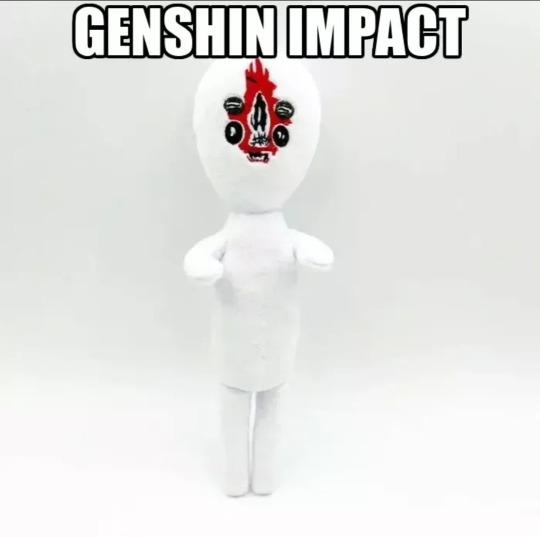


#scp#scp fandom#scp foundation#scp containment breach#scp shitpost#scp meme#scp 173#scp173#they whitewashed the peanut#even nahida is darker than him
213 notes
·
View notes
Note
Hiiiii. I saw your responses on another users asks about Lalaloopsy lore and would LOVE to talk Lalaloopsies with you. Please info dump to me 🙏
I want to hear it all (if that’s okay with you obvi)
On it! Under a cut cuz it's so long
So Lalaloopsy was originally created in about 2009 as Bitty Buttons, but the same had some copyright disputes so it was changed about about 12 dolls? The original 8 and the four succeeding them have very rare versions with this packaging.
Dolls were released in waves of about eight every season or so, outside of limited editions and such.
Initially, the canon was limited to the descriptions on the backs of the boxes, some books, and a few web and DS games, before the first animated universe came about, consisting of web shorts and a movie.
Eventually Nick Jr. picked up the franchise for six more movies, more shorts, and a two season TV series. Like all of the VAs for the franchise were nobodies except in the Lalaloopsy Girls movie for some reason.
Then the Nick show caused a lawsuit since the company behind Lalaloopsy (MGA) didn't pay as much for it as they said it would, which I assume didn't help with the steady decline of the brand (cheaper dolls, less creative ideas, etc), before Netflix picked it up for a show.
The Netflix show sorta bombed, they only made five dolls and some minis and I don't think anyone really cared outside of existing fans, a lot of which were turned off by the more realistic direction taken for the dolls and changes to the story, with fan favorite characters being omitted such as Peanut and Cloud E.
Lalaloopsy sort of died after the Netflix show until the 10th anniversary re-released in 2021ish, old and new dolls just like the old ones coming out and old songs and movies getting YouTube uploads. Nothing's really happened since but hey.
Fun facts: the series was racist a lot, I think they've been getting better but c'mon, Mittens, Mango, Sahara, Yuki, Feather, the fact that Dot was the darkest character and got like no merchandise, the whitewashing of Cinder, I think they've been rectifying some of these things lately thankfully.
They've tried to ride the coattails of mlp (ponies) and monster and ever after high (girls) to eh results
The Babies Diaper and Potty Surprise dolls probably foreshadowed the oddly scatalogical direction MGA has taken in recent years
Like everyone is neurodivergent coded in the Netflix series
People thought Suzette La Sweet and Crumpet Hearts were getting married in the Sew Royal Tea Party bundle
I think Rosy's design had to get changed because of violating Red Cross guidelines at some point
For some reason Bundles is shown with a pacifier a lot even though she's never come with one outside of a mini, same with Rosy's hat and Misty's gloves
(My dad used to put my dolls up in trees and it made me sad, that's neither fun nor a fact but)
30 notes
·
View notes
Text
Hi everyone! :3
I have introduced Acanthus before, so I want to introduce ALL of my hxh ocs, now complete with nen!
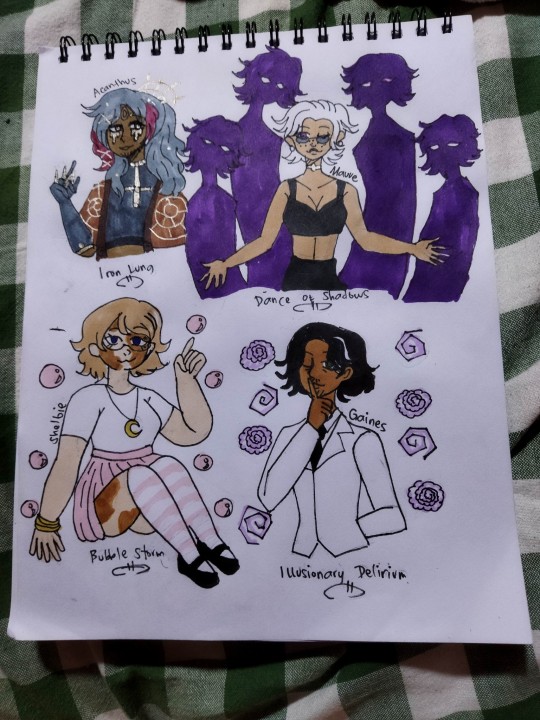
Here is a rundown of their nen:
Acanthus conjures thorns in his hands and has the ability to puncture thorns on an opponent's lungs. Mauve emits cloud of shadows to distract enemies but it's merely a distraction. Shelbie can transmute bubbles that can trap people or objects and even protect herself. Gaines can induce illusions/hallucinations in a person's mind, manipulating their reality as he pleases.

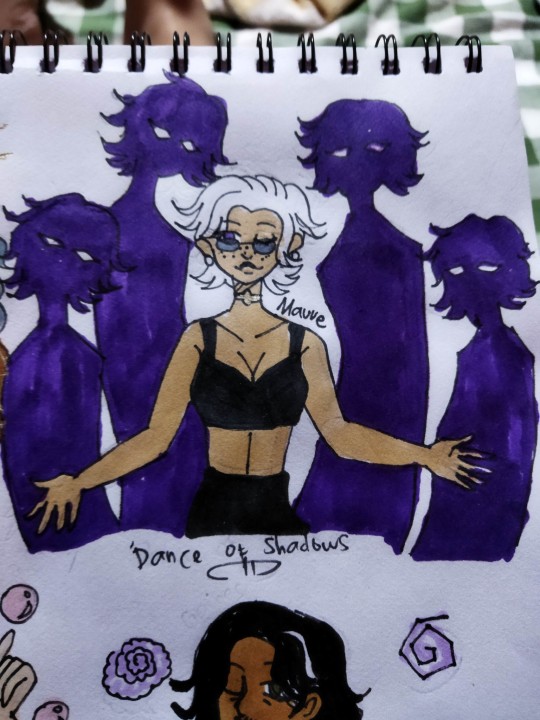
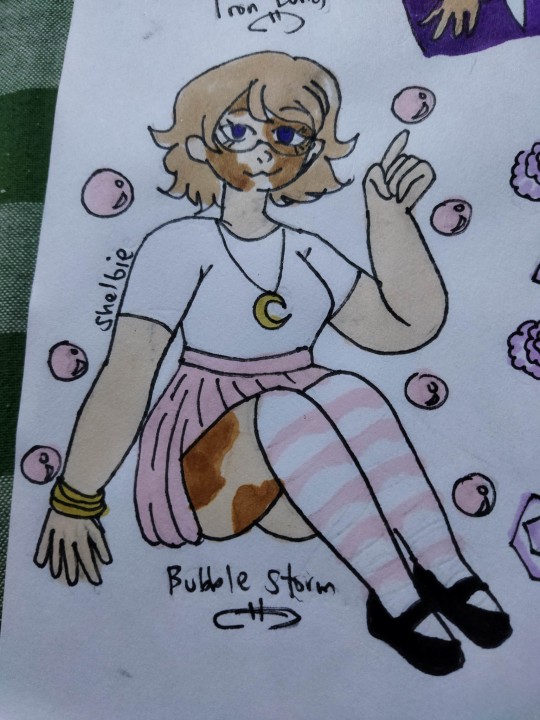
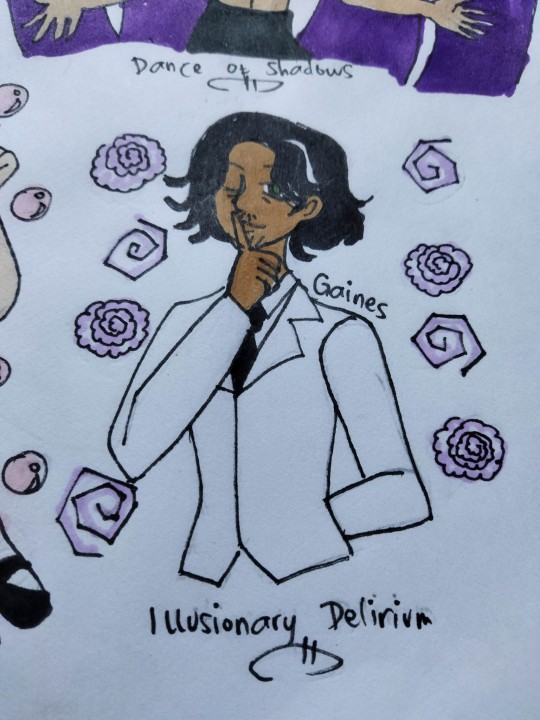
(Close-ups! They whitewashed my boy Gaines on the close up 😭😭)
Drawbacks: Acanthus needs contact for it to work. Mauve's ability is just a distraction, not an offense. Shelbie's nen can only trap things and her bubbles are harmless. Gaines's ability depends on the user's mental strength.
Also guys... I won third place in an essay writing contest... Guys... omg.

It was an essay about the peanut food industry! I am shaking
#hxh#hunter x hunter#art#artists on tumblr#hxh 2011#ocs#original character#hxh oc#hxh ocs#acanthus#gaines#shelbie#mauve
11 notes
·
View notes
Note
🔮 for Woljif please? Unless you'd rather do it for Sia.
Thank you Ash 💕 such a good prompt, I only hope I can do it justice.
cw: kids are bullies
On the cliffside edge of the slums a pack of street urchins squatted in the mud before the peeling whitewashed planks of a whorehouse, because in the early evening when the sunlight hit the wall just right it became their theater of shadow-animals. The only toys they owned.
He came up obliquely and hunkered down among them unnoticed. Underfoot his tattered boots crunched on shards of broken glass, fish bones and discarded ribbons.
By now he knew there were only two types of people: normal people and tieflings. Of course normal people came in all sorts of shapes, colors and sizes, and so did tieflings, but what set tieflings apart was the horns.
When he was small (it was funny to think about now, he was so naïve when he was five) he thought tieflings were scary. The other kids would point them out and spit, and whisper the word like an accusation, and sometimes they would run and hide from them as if they were dangerous, so of course he did too. And tieflings were ugly. A lot of them had snake eyes and pointy teeth, and a half-starved, shifty look he had learned very young meant trouble: volatile tempers, snatching hands.
Then his own horns started growing in, the baby nubs itching and cracking the skin as they pushed out between his curls and gradually began to spiral.
He couldn’t recall now the exact moment the realization struck his child’s mind but the shock of it still hit like a brick in the face.
I’m a tiefling.
The other children realized too, you can bet on it. He did recall all too clearly that exact moment: the time he was scratching until his nails came away red and Mag had done a double take, reached over and seized the little horn right out from between his curls and dragged him before the other children to put this outrage on public display.
I am not, I am not! Let go!
That was when the tail-pulling and rock-throwing started. Most of them flat out refused to play with him anymore. Only the beggar girl he and the other boys used to throw rocks at didn’t seem to mind, or even to notice, probably because she was loopy. She was twice his height and hopeless at hide-at-seek but it was something, at least.
If he slipped into the crowd unnoticed like this, sometimes they tolerated his presence. He projected a rabbit onto the wall that someone’s shadow-wolf tried to devour, and a little scene unfolded that made all the children laugh.
At some point Mag must have noticed him, though, because soon the bigger boy made a hand-shadow on the wall with both fists interlocked and two curled fingers sticking up.
“I’m a filthy tiefling,” Mag’s thumb made the shadow-puppet say.
Woljif’s eyes narrowed.
All the other children of the grubby peanut gallery raised their fists in an army of shadow-crusaders. “Kill the demon!”
Fury choking him, he watched as they chased Mag’s tiefling back and forth. He couldn’t let this go. They didn’t get it. He was a kid like them. The injustice of it rose like bile in his seven-year-old throat.
His tail whipped. He balled his fists. Don’t call attention, he heard Yger’s gravelly warning in his mind. Mind your mouth, boy, he heard Gran.
The shadow-crusaders piled on, trampling Mag’s bleating tiefling into the ground.
Enough. They were stupid.
“Tieflings are not demons!” he shouted at the top of his voice.
They all glared at him over their shoulders.
“Piss off, demon,” said Mag.
“You piss off!”
With a wicked look Mag began to raise one finger. To point and accuse, or to sic the other kids on him? No. With slow, determined malice he turned the finger toward the warped boards of the whorehouse wall.
“Look!”
Now that he was standing, the horned shadow he projected seemed to loom over the squatting children.
“Demon!” shouted Mag. “De-mon! De-mon! De-mon!” And the other children took up the chant.
Woljif felt a stinging in his eyes that threatened to betray him, a betrayal from which he knew he would never recover. His mouth pulled tight. By now he had mostly learned to swallow that all-too-familiar lump of searing hurt rising in his chest.
“Am not,” he corrected them in an almost steady voice.
They wouldn’t listen. They went on chanting.
If they wouldn’t listen he would have to show them. Eyes flicking to the wall he advanced closer so that his shadow got smaller, more like a regular kid’s, but they kept chanting until the burning shame in his throat rose and rose and caught fire like lamp oil, and suddenly his whole body shuddered as with a whoosh an unnatural blue flame erupted from his skin, bright against an encompassing darkness like a total eclipse blotting the sunlight. A cold breeze ruffled their hair.
For a moment there was not a sound. The children gaped.
It was like it had swallowed the sun. Black as the Abyss, goat-horned and bat-winged, burning with cold menace. Crouching in its shade, the petrified children suddenly looked like bug-eyed mudskippers, mouths opening and closing in silent terror.
And then they scattered.
“Yeah, run! You’ll see!” Woljif scooped up a handful of mud and lobbed it after Mag, but it was only once they’d all disappeared that he caught his ragged breath, wiped his nose and turned slowly, fearfully, to gaze upon his crime.
It was scary.
He looked all the way down to where it connected to his feet just like a normal shadow should, and then back up again.
It even had claws.
Afraid and yet too curious to resist, he raised one hand, and it raised its claw in mimic.
Huh.
He waved.
It waved back. Almost cheerful-like.
And then it receded in the orange sunset flooding across the Sellen, and he was alone again.
#thanks for the prompt!!#turbulentpumpkin43#woljif jefto#pathfinder: wrath of the righteous#pwotr pals
20 notes
·
View notes
Text

so we all know how disco elysium pays homage to the noir genre through its premise and tone, right? but have you thought about how it also hits a lot of the same plot beats as a spaghetti western? there's a lot of overlap between de and spaghetti westerns, so just stick with me babe, okay? firstly, the morality of the game is anything but clean cut. you can have harry do some fucked up shit because you're playing a cop and the game wants to hit home that legality and morality are not synonymous. harry just needs to do his job for the plot to progress. he doesn't have to be a good person to finish the game. next, alcoholism features heavily as a plot point. alcohol was everywhere in spaghetti westerns, and characters often struggle with alcohol addiction, though it's rare for the protagonist to be an alcoholic. a relatively surface level similarity is the fact that guns are present in both spaghetti westerns and de. then there's the fact that harry is a lawman. spaghettis feature lawman main characters often, if not in title then in spirit. even if a spaghetti doesn't explicitly name the progonist as a sheriff, he often fills the role of a peacekeeper or lawman through his persecution of the villains. also, martinaise is a great stand in for the common spagetti setting of a run down railroad town. practically all of the industry has left or been quashed out, leaving a town that's filled with the past and well on its way to becoming a ghost town (the fishing village especially). and another thing, babe - the townsfolk are (rightfully) hostile towards harry and kim, which is another common trope in spaghettis, a trope that's exacerbated not only by their status as lawmen, but by their status as outsiders (harry could even be called a drifter, if you play him as a hobocop). but one of the biggest similarities between de and the spaghetti western genre is the climatic shootout, right? you see, it's the culmination of the mounting tension weaved throughout the entire game. it takes place in the town square, and features most of the main players in the game. no matter what you say, it always ends in bullets and blood because that's the genre standard. you can't talk your way out of a standoff, in de or in a spaghetti western. the bad guys die, but so do some good guys, and you learn to live with it. then here's the big thing, so listen up: the number one similarity between spaghettis and de in my mind is the sense of time they both give you in their setting. spaghettis often deconstruct the concept of 'the wild west' by taking place in the twilight years of the west and showing the metaphorical death of the cowboy, or by showing a wild west that is bloody and cruel rather than whitewashed and hays-code friendly like the hollywood westerns were. de does both of these things - it's set after the revolution fails during a time of decline and failure, and it also doesn't shy away from the violence and death that comes with such a setting. so, even though it isn't a deliberate homage, i think de is a great example of a- oh shit, they're selling peanuts over there, babe, i'm gonna go get some, brb
#len's meta#disco elysium#disco elysium meta#i'm obsessed with this trend going around of meta posts accompanied by this picture soni decided to do my own#originally this was gonna be abt the boiadeiros but i couldn't generate anything interesting so it ended up being abt spaghettis instead
140 notes
·
View notes
Text

There are many graphics and charts in this story that you might want to view - so click the header and visit the site directly to see them all
The history of Black people’s contributions to the catalog of inventions that marked the Industrial Revolution has been largely muted. This period is considered one of the most innovative eras in world history, seeing the birth of major advances in agriculture, transportation, communications, manufacturing, and electricity that fueled rapid economic growth. With the exception of a few notable inventors who are regularly elevated during Black History Month—e.g., George Washington Carver (peanut products) and Madam C. J. Walker (hair products)—the disregard of many of the era’s Black inventors not only whitewashes the historical record, but biases who we perceive to be innovators in the present.
Using a new database of inventors, this report demonstrates that Black contributions to the Industrial Revolution were influenced by the disproportionate number of Black Americans who lived in the U.S. South in the late 19th and early 20th century, where their opportunities to acquire and apply skills were severely limited by oppressive institutions. Still, Black Americans living outside the South invented nearly as frequently as white Americans, and at rates that would be considered extremely high by historic or global standards of invention even today. We use a novel database created by Sarada, Michael Andrews, and Nicolas Ziebarth that matches inventors listed on patent records in decennial years from 1870 to 1940 to complete census records, which include demographic information for the named inventors.1
The data reveals the following:
From 1870 to 1940, Black people living in the North were eight times more likely to be awarded a patent than Black people living in the South. White people in the North were three times more likely to invent a patented technology than white people in the South, but regional effects were weaker for white people and they were much less concentrated in the South than Black people.
In the North, Black people’s share of patents equaled their share of population. Black people accounted for 1.6% of the North’s population and 1.6% of patents across the decades studied. The rate of patenting per capita among northern Black and white residents was extremely high (0.31 per 1,000 residents for Black people and 0.39 for white people). Both of these rates exceed the U.S. rate of invention for most of the country’s history and approach the highest rates observed around the world today at the country level.2
With 50,000 total patents, Black people accounted for more inventions during this period than immigrants from every country except England and Germany. In our database, 87% of inventions were traced to people born in the United States, and 2.7% of the U.S. total were invented by Black Americans, which is a larger share than nearly every immigrant group. After accounting for patents during nondecennial years, we estimate that Black people accounted for just under 50,000 total patents during this period.
Given the vast differences between the North and South in providing both skill-generating and skill-using opportunities, this historical research points to the importance of linking political equality and social opportunity to innovation and economic growth. It also provides a reassessment and revaluation of the extraordinary contributions of Black people in the development of the United States as well as global technological advancements.
Back to top ⇑
Introduction
In leading theories of economic growth, technology and innovation are the driving forces of long-term gains in living standards.3 Ideas—developed and commercialized—are key to innovation, and economics literature has long recognized that patents offer a valuable measure of invention. Patents were particularly important during the so-called Golden Age of Invention (1870 to 1940), or the second phase of the Industrial Revolution, which was characterized by an unprecedented flowering of economic growth and advances in living standards.4 As historians have documented, people living in the United States contributed disproportionately to this rise.
It is widely believed that Black Americans did not participate in the Industrial Revolution, as suggested by several recently published papers.5 Likewise, contemporary estimates report that Black people are much less likely to become inventors than whites, Asian Americans, and immigrants.
Our estimates for total patents by Black people during the Golden Age of Invention are similar to those previously published. We use the same database as used in Sarada et al., but we emphasize the importance of regional differences and how legal and cultural institutions in the South were particularly harmful to Black people. In this way, we build on the research of economist Lisa Cook, who is the only scholar we know of who has systematically analyzed how Jim Crow laws suppressed invention among Black people.6 We extend her work by using a more comprehensive measure of inventors, one that links patent records to newly released digital data from the U.S. Census Bureau for relevant years during the 1870 to 1940 period.
Our conclusion supports the arguments developed in Jonathan Rothwell’s A Republic of Equals, which concluded that educational achievement, innovation, and entrepreneurship were widespread in the North’s Black community in the decades between the end of slavery and beginning of Jim Crow.7
Back to top ⇑
Methods
This article draws on a more detailed analysis from Jonathan Rothwell and Mike Andrews, recently published as a working academic paper. Interested readers should consult the methods section of that paper and see the discussion for further information.8
Patent records do not record the race of the inventor or other demographic information, other than their name and address. The key benefits of the Sarada, Andrews, and Ziebarth database is that it links these records to census data, unlocking valuable demographic information.
This database is extremely useful for comparing across groups of people and regions to understand where patented inventions came from and who developed the technologies. However, it is not a complete record of every patent developed during the period. Census records are not available for nondecennial years, and while many people identified in the decennial census would also be identified in interdecennial years, the fact that many would have changed addresses complicates direct matching.
Even during decennial years, matching a patent record to a census record is far from guaranteed. State and local geographies often use abbreviations or uncommon spellings. The name of the inventor may be abbreviated or misspelled. Overall, our database accounts for 19% of domestic patents for the relevant years, with nine years of missing data during each decade.
Because of these information gaps, we impute actual domestic utility patents from the U.S. Patent and Trademark Office to groups identified in our database using the group share for the relevant year and geography. For example, we find that 2.7% of all patents went to Black inventors, so a good estimate of the total number of inventions by Black inventors is .027 times the total number of recorded inventions of U.S. residents. In practice, the 2.7% share varies by year, so we assign the nearest decennial year estimate to the years in between to get a more precise estimate. A rule of thumb is that the number of patents observed in our database should be multiplied by 5.4 to account for missing matches, which we have reason to believe are largely random by group. The statistics below are careful to distinguish the estimated actual numbers from the lower numbers derived from the database.
Back to top ⇑
Findings
From 1870 to 1940, Black people living in the North were eight times more likely to be awarded a patent than Black people living in the South. White people in the North were three times more likely to invent a patented technology than white people in the South, but they were much less likely to live in the South than Black people.
White Americans were 4.6 times more likely to patent than Black Americans during the entire period of 1870 to 1940, as other scholars have documented. That rate fluctuated somewhat, but remained fairly constant. A superficial interpretation of this result is that Black Americans faced enduring obstacles throughout the country that resulted in consistently low rates of patenting.
However, underlying this pattern is the fact that during this period, Black Americans were born and raised mostly in the U.S. South, where the institutional environment was radically different with respect to both race and invention. The share of African Americans living in the South went from 90% in 1870 to 77% in 1940. Meanwhile, only one-quarter (26%) of white Americans lived in the South throughout the period. Despite the lopsided share of African Americans living in the South, northern African Americans filed the majority of patents (58% is the average for the entire period), with the North’s patenting share reaching 71% by 1940. Most patents filed by white Americans also came from northern residents (90%), reflecting regional differences in education and industrial concentrations.
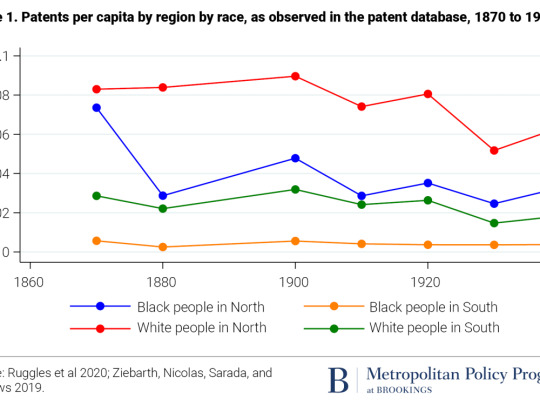
The data suggests these regional institutional differences explain quite a lot. Across the period, Black people living in northern U.S. states were eight times more likely to patent than Black people living in southern states (Figure 1). The regional gap for white inventors is also large, in that northern white people were three times more likely to patent than their southern counterparts—but that is only one-third as strong as the effect on Black invention. A simple interpretation of these facts is that poor social and economic resources (e.g., lack of education, research and development, and industry) limited invention in the South by a factor of three, whereas systemic racism had an even larger effect—albeit only on the Black population. Black people in the North were almost as likely to file a patent as white people in the North, and they were far more likely to patent than white people in the South.
To put in perspective the extraordinary number of patents given to Black people in the North in the decades after the end of slavery, consider that patenting in northern Black communities was equal to white Americans nationally. During this era, the United States was arguably the most inventive place on Earth at what was arguably the most inventive era in world history. This puts northern Black people in the global vanguard of invention in the late 19th and early 20th century.
We also considered what these patenting rates look like by region of birth. This distinction is important in analyzing the causes of different patenting rates by region. A state could be better at providing Black people learning opportunities, practice opportunities, or both. A state that provides only practice opportunities may provide no advantages to people born there, but may be a welcoming destination to highly skilled migrants.
The patenting rates by region of birth are largely consistent with patenting by region of residence. For both races, patenting rates are slightly higher by region of residence, consistent with there being both learning and practice opportunity effects in northern states. Whether using state of birth or residence, the broad regional distinctions are still evident, and the data is clear that northern Black patenting rates were high by either definition.
In the North, Black people’s share of patents equaled their share of population. Black people accounted for 1.6% of the North’s population and 1.6% of patents from 1870 to 1940. The rate of patenting per capita among northern Black and white residents was extremely high (0.31 per 1,000 residents for Black people and 0.39 for white people). Both of these rates exceed the U.S. rate of invention for most of the country’s history, and approach the highest rates observed around the world today at the country level.9
On average, Black patenting rates are lower than white patenting rates in the same state, but there are several notable exceptions (Table 2). In Washington, Maine, Colorado, Pennsylvania, and Indiana, both patenting by residents and patenting by those born in the state are higher for Black people than white people. In Wisconsin, Black patenting rates are roughly the same as white rates for residents, but Black patenting is much higher by birth—suggesting that Wisconsin provided especially advantageous learning opportunities. In New York, Michigan, and Ohio, patenting rates were essentially the same between Black and white people, whether by residence or birth.
In southern states, patenting is almost uniformly lower for white and Black people, but some of the within-race comparisons are instructive. In states with heavy historical slave populations—such as Alabama, South Carolina, Georgia, Mississippi, Texas, and Florida—patenting was much higher for Black people who were born there than patenting by residence. This suggests that these states were especially bad at providing practice opportunities, but many Black people born there achieved inventive success elsewhere after migrating.
Table 1. Patents per million population observed in the patent database by race and state of residence and birth, 1870 to 1940 (cumulative)Black peopleWhite people
State of residenceState of birth State of residenceState of birth
District of Columbia 201.5 140.7 491.6 300.4 Massachusetts 188.3 120.4 222.9 179.9 Washington 151.6 117.9 87.0 33.5 Maine 111.0 413.3 65.0 137.7 New York 100.9 96.7 98.0 97.1 Connecticut 100.6 96.7 293.7 223.9 Colorado 79.7 70.1 71.4 51.1 Delaware 74.7 63.0 174.5 114.3 Pennsylvania 59.1 67.9 49.3 52.5 California 58.7 25.6 84.9 53.7 New Jersey 57.9 57.0 219.3 121.6 Illinois 57.2 39.0 53.4 44.2 Maryland 50.9 51.7 133.0 115.7 Michigan 41.1 40.7 48.0 45.5 Ohio 36.4 46.4 45.5 50.9 Wisconsin 34.8 77.4 38.6 39.9 Indiana 30.4 45.7 26.8 36.3 Kansas 19.6 19.6 12.9 35.6 Utah 14.8 513.1 84.9 58.2 Minnesota 14.7 10.1 28.9 31.9 Missouri 13.2 13.5 24.5 29.2 Iowa 9.5 102.9 16.2 28.5 Oregon 7.5 16.1 81.3 49.0 Tennessee 6.5 11.8 11.8 14.2 Florida 6.3 8.3 29.5 23.3 Louisiana 6.1 5.8 25.9 23.7 Oklahoma 5.8 9.7 17.1 11.6 Kentucky 4.5 9.2 10.4 19.0 Alabama 2.8 5.3 10.3 13.2 Texas 1.9 2.4 7.6 9.4 South Carolina 1.6 6.1 15.4 21.0 Mississippi 1.4 4.8 8.9 11.4 Georgia 1.0 4.7 7.6 13.9 Arkansas 1.0 2.4 6.1 7.8 North Carolina 0.4 5.2 7.0 12.9 New Hampshire 0.0 501.4 78.4 184.9 Vermont 0.0 158.2 88.5 147.4 Nebraska 0.0 25.9 12.2 26.4 Idaho 0.0 0.0 42.1 19.9 North Dakota 0.0 0.0 19.0 20.0 Arizona 0.0 0.0 34.0 44.7 South Dakota 0.0 0.0 15.3 23.8 Wyoming 0.0 22.9 43.8 47.1 New Mexico 0.0 0.0 19.6 14.2 Nevada 0.0 0.0 73.5 79.6 West Virginia 0.0 7.8 1.1 13.1 Hawaii 0.0 0.0 18.3 23.8 Montana 0.0 0.0 0.0 36.7 Rhode Island 0.0 40.7 0.0 65.1 Virginia 0.0 20.9 0.0 31.5 Alaska 0.0 0.0 0.0 1097.7
To put these numbers in perspective, we can compare them to contemporary patent rates in America’s most prolific innovation hubs. To do so, we multiple by 5.4 to account for missing records. From 2007 to 2011, there were 296 patents granted per million residents of U.S. metropolitan areas, according to previous Brookings research.10 From 1870 to 1940, adjusted Black patenting rates exceeded 300 per million in 12 states.
Compared to other states and territories, Black residents of Washington, D.C. had the highest rate of patenting during this golden age, with 1,088 patents per million Black residents, after adjusting for missing data. This rate is roughly equal to contemporary San Francisco and Seattle, though somewhat lower than contemporary San Jose, Calif. In recent years (2007 to 2011), only 16 metropolitan areas exceeded the rate of patenting reached by Black residents in Washington, D.C. from 1870 to 1940.
Other Brookings research allows us to put this in an international perspective. We estimate that northern Black Americans had a rate of 300 patents per million residents, after adjusting for missing records. Japan was the only country in the world to patent at a higher rate from 2010 to 2012.11
With 50,000 total patents, Black people accounted for more inventions during this period than immigrants from every country except England and Germany. In our database, 87% of inventions were traced to people born in the United States, and 2.7% were invented by Black Americans—a larger share than nearly every immigrant group. After accounting for patents during nondecennial years, we estimate that Black people accounted for just under 50,000 total patents during this period.
It is widely known that immigrants to the United States contributed disproportionately to entrepreneurship and innovation, and continue to do so today. Yet it is also the case that during the Golden Age of Invention, most inventions (87%) came from people born in the United States. Black people were among the most important contributors to this, accounting for more patents than immigrants from any country except Germany and England.
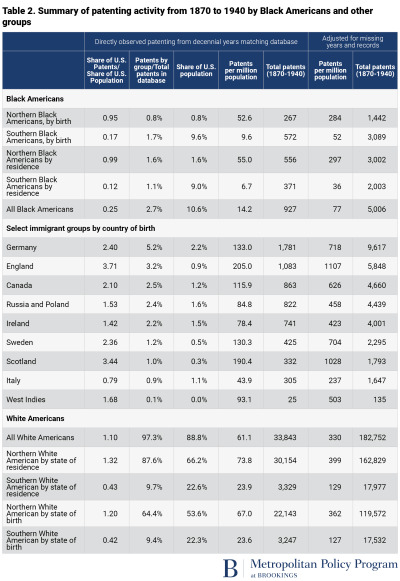
To understand the rate of patenting by northern Black Americans during this period, we compare it to the average rate of patenting throughout U.S. history. A few observations stand out (Figure 2).
First, the Golden Age truly was remarkable for its rate of innovation. No other time in the 19th or 20th century saw rates of patenting matched by the period from 1870 to 1940. In the late 20th and early 21st century, the introduction of software patents has contributed to the increase in patenting, along with much higher rates of postsecondary education and research and development spending per capita.12 Second, Black patenting by northern residents during this period should be considered extremely high relative to the national rate at any time in U.S. history. Simply put, from the period after the end of the Civil War to start of World War II, northern Black people were among the most inventive people in world history.
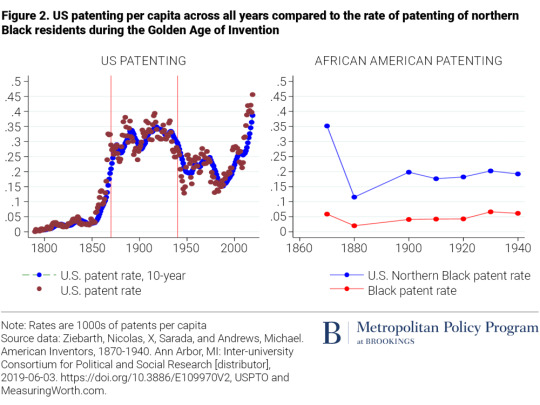
Back to top ⇑
Discussion
Perhaps the earliest and most ambitious attempt to measure the contribution of Black people to U.S. invention was made by Henry Baker, who worked at the U.S. Patent Office. In 1913, he surveyed approximately 8,000 registered patent attorneys, found 1,200 inventions attributed to people of African American ancestry, and was able to confirm 800 of them.13 He emphasized that this was a large undercount, as attorneys reported failing to recall the names or inventions of some of their Black clients. Our database suggests that Black people were producing roughly 800 patents per year during the decade of Baker’s work.
“We can never know the whole story,” Baker wrote in a 1913 pamphlet. “But we know enough to feel sure that if others knew the story even as we ourselves know it, it would present us in a somewhat different light to the judgment of our fellow men, and, perhaps, make for us a position of new importance in the industrial activities of our country.”
In this spirit, we follow Baker’s lead and describe some of the Black inventors who shaped the history of technology:
Lewis Latimer was born in Massachusetts in 1848 to escaped former slaves. He became a leading electronics engineer, making technical drawings for Alexander Graham Bell, contributing to the development of telephones, and later working for Thomas Edison on improvements to lighting.14
Elijah McCoy was also the son of African American parents who escaped slavery. He was born in Canada but raised in Michigan, before being sent to study in Scotland at age 15. McCoy was denied work as an engineer based on his race, and had to settle for work as a railway technician. In that context, he developed and patented an automated system for wheel lubrication, greatly improving the efficiency of train travel. He went on to have a lengthy career as an inventor.15
Granville Woods was another influential Black inventor of the era, born in Ohio in 1856. He made fundamental innovations to railways, especially in the form of communication systems and the distribution of electricity to the rail cars.16
Sarah Boone invented the ironing board, winning a patent in 1892. She was raised in New Haven, Conn. by African American parents who escaped from slavery in North Carolina through the Underground Railroad.17
Despite living and working in the North, these and other Black inventors, entrepreneurs, and workers of all kinds faced discrimination and professional and financial barriers that white people did not.18 Obtaining a patent was more difficult for Black people, because it often involved working with a white lawyer who may be tempted to engage in unfair dealings. These obstacles, no doubt, suppressed the wealth, fame, and influence of Black inventors—and yet, many succeeded in making important contributions to American technological and economic development. What is striking is that even while lacking complete liberty, Black people in the North acquired and practiced cutting-edge creativity, science, and technical skills at very high rates for a substantial period of U.S. history.
Several important institutions changed in the North that help explain why opportunities for Black advancement seem to have stalled and even reversed after the Golden Age of Invention. The 1920s saw the birth of zoning laws and other government-backed institutions that closed off real estate markets to Black people, leading to rapid increases in racial segregation which did not reach their peak until the 1970s.19 With racial segregation made either an explicit goal or viewed as an unavoidable side effect, governments around the country fostered segregation and corralled Black people into areas that were targeted for disinvestment in important public resources, including education.20 Meanwhile, powerful professional associations—including the American Bar Association and American Medical Association—gained prominence in the early 20th century and used their emerging power, in part, to officially discriminate against Black people for decades.
Throughout northern states, the Golden Age of Invention in America provided a tantalizing glimpse into what Black people could accomplish if given robust opportunities to learn and practice in highly skilled fields. These accomplishments negated the assumption—once held by many in America—that Black people cannot thrive just as well as any other group at the most challenging cognitive activities. National leaders should apply this historical lesson to today’s institutional landscape, and seek out and eliminate barriers to the full participation of Black people in American life.
#Black Innovators#Black Inventors#Black Industrial Revolution#The Black innovators who elevated the United States: Reassessing the Golden Age of Invention
14 notes
·
View notes
Note
Hey I saw you reblogging a bunch of mcu hate posts and just so you know any other reason to hate it is that they whitewashed Wanda Maximoff. In the comics she’s Romani (+ Jewish) (usually draws as white passing but that’s not the same as white) but in the movies she’s white (+ Christian)
i primarily hate the mcu currently because their storylines are manufactured situations that come off the assembly line with crappy work done by underpaid and disrespected artists and writers who are expected to constantly put out new content in a world that screams that "good" is unnecessary, quantity is the new good, and that any single story must be the same as the one before and you must constantly disrespect what came before you(see the scene where She-Hulk Who Is Not Yet She-Hulk Talks Trash About My Favorite Murica Man) and put them through the blender and make all the old characters push overs and weak in retrospect and yada yada yada
but
bi s h
WHAT

HOLD UP WAIT

YOURE SAYING
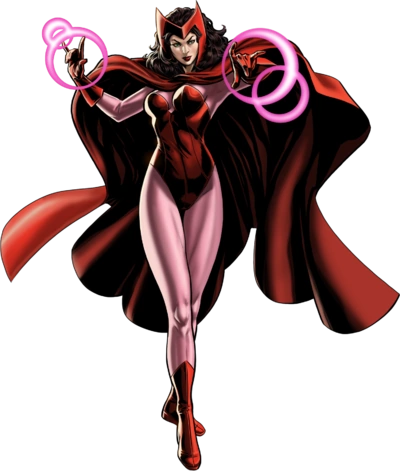
THAT WANDA
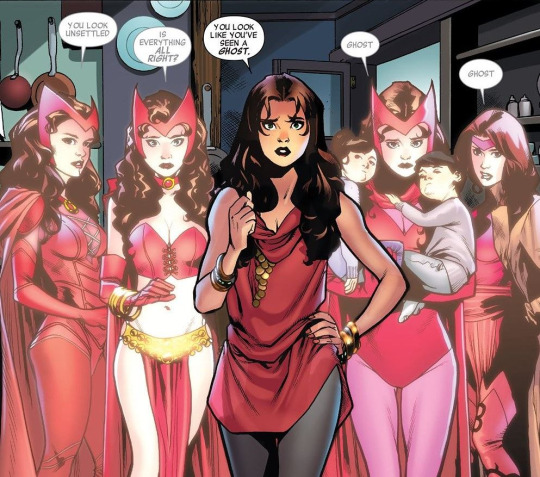
WAIT WAIT WAIT WAIT
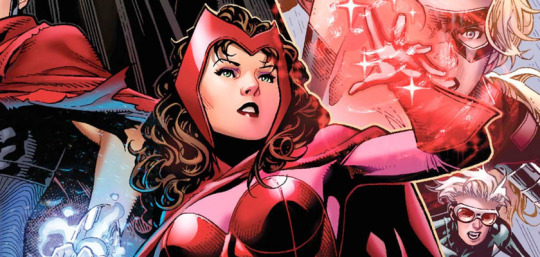
SHE'S NOT SUPPOSED TO BE--
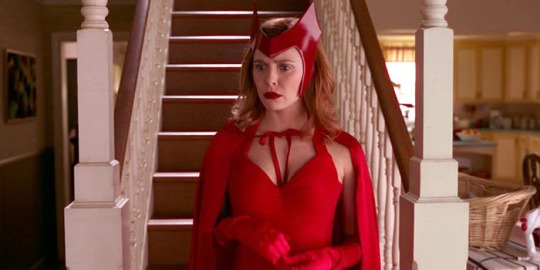
well if that don't put mayo on my peanut butter and serve it in a smoothie
29 notes
·
View notes
Text
179: Elvis Presley // The Sun Collection

The Sun Collection
Elvis Presley
1975, RCA Victor
Is there anything left worth writing about Elvis? Well, people still find smart things to say about Jesus. Getting through all the muck around him took some doing for me, and it was probably the mythic intensity of Nick Tosches and Greil Marcus’s writing on his career (and particularly the Sun Sessions) that gave me a framework for understanding what made him so electric, something more than the pancake-foundationed Engelbert Humperdinck- or Wayne Newton-type Vegas tchotchke he seemed to be. I don’t have a ton to add to the conversation around Presley, but I was curious about how people think about him these days, whether they still have any strong opinions at all. I asked a bunch of friends (and my grandma) to give me their impressions of the King, and their thoughts follow.
youtube
18 Takes on the King
“I guess he's like a sexy (not as in attractive, but more like assuming the affectation of sex) Gumby who was the perfect conduit for music producers looking to extract culture from Black communities, can it, and sell it to white America like tinned fish. It's like if Hank Hill had a verbal aphasia and could only stutter vowel sounds, but it somehow still slaps despite the odds.”
“The quintessential model for a pop star who is overtly sexualized but also somehow innocent or naïve. This presentation can range from cool to creepy. Elvis didn’t do it first, but he did it the best to that point and his version came off on the cooler end of that spectrum.”
“Elvis isn’t my thing, but without him I don’t know what ‘90s independent cinema would even be.”

“I have conflicted feelings about Elvis—while I think there's something truly timeless and unique about the timbre of his voice and the way he sings (my family plays his Christmas record on Christmas Day without fail every year), I also recognize that he is overrated in that his material is neither original nor is it particularly revolutionary in any way, and if anything is just a glossed, whitewashed version of music that already existed previously that white audiences couldn’t handle. But ultimately, I do legitimately like listening to his music.”
“I’m not a major Elvis person, but early rock dude who combined gospel/blues with the developing genre of rock. Don’t think he ever claimed to be THE GUY who created the genre and from the little I know, he acknowledged the importance of Black artists in inspiring what he did. Particularly known for his cover of ‘Hound Dog.’ There we go.”
“Elvis Presley, the hip-shaking maestro of rock 'n' roll, could make even a hound dog blush with envy. His voice was smoother than peanut butter on a hot skillet, and his hair was so iconic, it had its own fan club. If music be the food of love, then Elvis was the chef who cooked up a whole lotta heart-throbbing tunes! (ChatGPT lol, sorry, busy day at work!)”
“A bejewelled sex wizard.”

“Elvis Presley allegedly came in his all-leather flight suit during his iconic ‘comeback’ special. He is one of a select few celebrities with a fervently believed rumour of being not-dead. People dress as him and marry other people together. Also, he invented a sandwich. — King Status”
“Mediocre singer who abused women and whose signature sandwich is overrated.”
“His career ate him up, then he ate everything else.”
“The King of Ripping Off Other Artists. My earliest memories of Elvis are my family listening to the Christmas album ad nauseum, but they’re good memories nonetheless. Regardless of how you feel about Elvis, you must admit ‘Jailhouse Rock’ fucking RIPS.”
“White as winter snow
pills jam and peanut butter
A king on his throne”
“A lot of people dismiss Elvis because of an opinion they've been told to have and have never really critically assessed, and I imagine a lot of people you ask about this will give you the standard take; I'm not going to fault them that, I think a lot of us have opinions like that, it's not really efficient to assess the validity of every single one of our received assumptions.
There's an absolutely dogshit short story by Alice Walker about an Elvis stand-in character and a Mama Lou Thornton stand-in character, which seems to imply that Thornton wrote ‘Hound Dog’ herself and was effectively exploited and that Elvis isn't a real artist because he can't write his own songs, which is a crock of shit because: two Jewish white guys wrote the song for Thornton; she made it a #1 record; and performance IS real artistry and Thornton, like Elvis, was a real artist and interpreted the song in a very powerful way.
The fact is, you listen to that Ed Sullivan ‘Hound Dog’ performance, and it doesn't take much to see how different it is from the original—not ‘better’ or ‘worse’ but very obviously distinct, and if you tell me otherwise you are absolutely approaching it in bad faith and there's no reason for me to even waste my time explaining that to you.
Elvis absolutely kicks the doors down in the opening bar of his version of ‘Hound Dog,’ it sounds extremely dangerous and you can immediately see why he scared parents—he was wild and in-your-face, an extremely prescient innovator who sounded totally unlike anything that came before him no matter what the haters mindlessly repeat, and he WAS a true contender for the title of King of Rock & Roll.”
“My ability to produce an opinion here was contaminated by the Baz Luhrmann movie.”
“apparently influential in bringing some sort of music (maybe it’s dance hall music) to white America but I dunno really
also he died on the toilet
or maybe aliens got him
not sure”
“A man with a good heart, in a physique of timeless beauty that comes along once in a civilization. True to his roots, and the foundation of his time, he kept his focus on God. However, his body and mind went wayward to a decadence not uncharacteristic of the chapter unto which he was born. His Spirit shone through regardless, right to the end.”
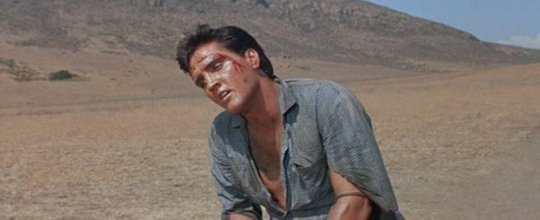
“Elvis is America in the sense that his impact was so seismic and society changed so rapidly while he was active that he basically had to become a nostalgia peddler for like, his own vibe in his own time. He went from Little Richard to Michael Bublé in like a year and a half.
He’s a perfect representation of suspended youth in that I think a lot of what makes him so iconic is that all his excesses (Graceland, the Outfits, the Karate, the Sandwiches) are basically a broke 12-year-old boy’s version of what being rich and famous looks like, which objectively rocks.
His best record is a Christmas album which I think is an appropriate celebration and condemnation of his legacy.”
“He was my youth. 😊 He was my exam study music! I loved him and his music and his movies. I still love him!”
youtube
179/365
#elvis#elvis presley#'50s music#sun sessions#crowdsourcing#'50s rock#rock n roll#american mythology#music review#vinyl record
6 notes
·
View notes
Text
@ethanvanii, i noticed that a user named @princesshillaryellaworld25 is supporting PonyCentral despite that PonyCentral is a terrible person and i'm afraid that PonyCentral will groom her as well just like me in the sexual roleplay incident when she added mass debation (I sugarcoated the word m*sturb*tion to avoid explicit issues) and sexual things in her roleplays, she also groomed me into doing sexual roleplays (with barely disguised fetishes and explicit content) despite that i'm minor (being 14 years old) meaning that she reverse groomed me as well. That pedophile groomed me into doing sexual roleplays even though i'm not comfy with those contents. If i see PonyCentral, i will not interact with her at all and i blocked her for my own good. She also sended death threats to Natt and @starlightgirl242, which made starlight scared to the point that she cried. I blocked that woman so that she won't frighten Starlight anymore. What's worse is that Hillaryella worships PonyCentral as a god, Hillaryella needs to seek help and stop supporting PonyCentral for all eternity. She is also a racist, transphobic, zoophilic, problematic whitewasher which means she whitewashed Natt, Juan, Edric, Cyrus and misgendering Natt on purpose and ships Naughty BF (A Pekoponian) with Naughty PC (An alicorn) and threatens people who don't support this ship, while i love shipping characters, i have my own standards which i don't support zoophilia, adult x child ships, incest, selfcest, etc. She disguises her sexual roleplays as normal roleplays to trick and convince people into thinking the roleplays are normal which is also grooming. PonyCentral considers Natt as an enemy just for being a slacker when he's actually busy with his exams and mental health and does she do? She whitewashes, misgenders and deadnames him on purpose. Smart move. PonyCentral. Smart Move/Sarcasm
I stated in an earlier post that i was a victim of PonyCentral's grooming and pedophilia and as i saw Cyrus' document, i saw that she saw PonyCentral doing Rule 34 art of Sick BF and DSSBF which is incest and selfcest at the same time (i noticed that her headcanon is that Sick BF and DSSBF are cousins), she also did NSFW of Naughty BF giving BFWow a handjob which is also incest, pedophilia and selfcest at the same FUCKING time, even worse is that BFWow sees Naughty BF as a father figure in her headcanon which escalates into the worst part. She also ships one of her OCs Sick PC with Sick Patrick even though Sick Patrick has no known lovers in the canon which makes PonyCentral very dumb as a peanut and a total dumbass. I hope PonyCentral leaves the Spongebob Parodies community and Tumblr for total good.
Also PonyCentral is also a sore loser and a spoiled brat who throws tanturms whenever she loses or doesn't get whatever she wants, damn someone needs to get PonyCentral seek help and send her to an asylum or a mental prison.
#ponycentralislonelyandfatherless#ponycentraldrools#ethanvaniiyesponycentralno#ponycentralisasoreloser
1 note
·
View note
Note
have you done a garroth fit check or zenix? what about jeoffery? sorry i just miss bitches lol
wait brendan had like 2 outfits {at least mys, forgot for mcd} and they were drab as hell if memory serves right
Garroth has a lot of fits so he gets his own post but here is everyone else anon!!
MYSTREET FIT REVIEW - BRENDAN
MYSTREET - CASUAL

Brendan's casual fit screams background character. Dark green shirt with black pants do nothing to help him stand out. The red converse are the only part of his design that stands out, but I'm not really sure why they're there in the first place (maybe a refrence to Kiki??).
Luckily for Brendan, he's so minor his boringness adds to the design instead of detracting.
7/10
MYSTREET - SUMMER
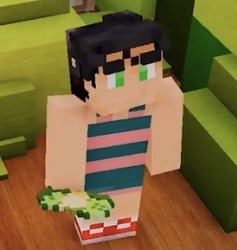
Brendan took everyone's insurance money and bought himself whatever...this is. Pink and deep teal is a banger color combo, but the red sneakers still seem out of place. I'm also not sure if he's wearing a one piece or just a coordinated two piece. Might be a swimsuit but there's no reason for Brendan to wear one.
5/10
TOTAL SCORE - 6/10
—
MYSTREET FIT REVIEW - JEFFORY
MYSTREET SEASON ONE - CASUAL

Lovingly bland. Dorky sweater in a similar gray/white/green to his Jury uniform is both recognizable and weather appropriate. Khaki pants fitting of a dad. Gorgeous.
10/10
PHOENIX DROP HIGH - CASUAL

Jeffory in the uniform is really just okay. The abundance of green eye brunette boys in PDH make him come off like a background character. Fairly certain Zane’s goons in PDH s2 stand out just as much and Jeffory does, and they don't even speak.
4/10
PHEONIX DROP HIGH - FORMAL

Apologies for the poor lighting. Jeffory only wears his formal fit at prom so we never see it in a good atmosphere. From what I can tell, its really just a basic black and white tux. There's a black strip near the collar that could be a bow tie or a ribbon. And the lapel flowers compliment his eyes.
8/10
TOTAL SCORE - 7.3/10
—
MYSTREET FIT REVIEW - ZENIX
PHEONIX DROP HIGH - UNIFORM
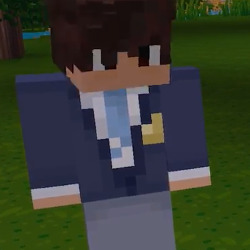
Fortunately, Zenix's hair and eyes are neutral and don't clash with the blues of the uniform. Zenix buttons his blazer the same way Gene does, which is a neat little character detail I enjoy very much.
8/10
PHOENIX DROP HIGH - CASUAL

Zenix really said minecraft bad boy. He has stolen his grey and black striped hoodie from Zane’s closet, a direct homage to Garroth considering Zenix to be like his little brother in MCD. The white undershirt and black pants fortunately steer clear of flat white and black, which are saved for accessories and shoes. Keeling the entire fit in grayscale allows the values to stand out, making the design readable.
9/10
MYSTREET - CASUAL

Hate the whitewashing but the fit itself is nice and funky. Love the black jacket with the white fur and the bright red/pink buttons. Putting the button color on the shirt stripes is s neat idea, but it clashes with the gray. The blue of the pants is the same value as the brown of his weirdly coordinated belt/shoes.
5/10 for the jacket alone
UPSIDE DOWN STORIES - CASUAL

Zenix's Laurance arc, made dumber by the addition of a white shirt under the polo. This implies that UP!Zenix is supposed to parallel Laurance?? Which is a weird choice since UP!Zenix acts nothing like Laurance. Jesson later gives any notable Laurance traits (soccer captain and popularity) to UP!Zane, who is a combination Jeffory/Garroth/Laurance hybrid...who is not Zenix. Deadass UP!Zenix doesn't have any parallels outside of this one fit. Unless normal Laurance is notoriously into peanut butter Laurance stans help me out here-
1/10
SIDE STORIES - CASUAL
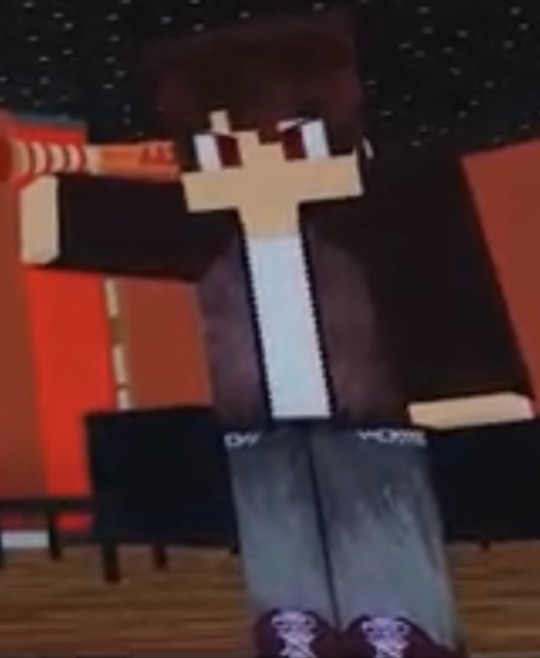
Again, loses points for whitewashing. The burgundy brown varisty jacket with matching shoes is fine, if not bland. Adding the white t shirt and normal denim jeans really gives off high school Garroth energy. Look at that he evern has a baseball bat. At least the chains on the jeans are a tiny, but in character detail
4/10
TOTAL SCORE - 5.4/10
#aphmau#aphmau mystreet#mystreet#aphmau zenix#aphmau laurance#aphmau brendan#mystreet brendan#mystreet zenix#mystreet jeffory#aphmau jeffory#jeffory the golden heart#fit review#phoenix drop high#aphmau shadow knight#no seriously laurance fans does he like peanut butter??
35 notes
·
View notes
Note
hi! black person here and i just gotta say that a lot of the things youre saying are wrong and potentially harmful to the fandom and others, such other poc who may project. i would also like to clarify that cracker is not a slur, if thats what you were referring to in that one post. there are no white slurs.
homestuck was written from a white and yes, most likely racist perspective, however bad representation is still representation. erasing the poc coding in these characters is arguably whitewashing. thats really all i have to say on the matter
my apologies for this being long, but i do wanna ask one question. can you explain how janeroxy is toxic?? without the epilogues and hs2, preferably, since i dont care for those at all.
Hey that post where I said cracker was a slur was me being misinformed and I corrected myself on it. And honestly I don't have a problem with hc roxy or any of the characters being black, it becomes a problem when people mistake fanon for canon without addressing the issues of why they have that hc. And I've already discussed how this Fandom is applying poc coding that isn't actually there and is in fact the opposite. For example in homestuck equius calls out gamzee for acting like a low blood and in homestuck low bloods are the poc off alternia. Equius constantly tells gamzee his behavior isn't normal for a purple blood but because gamzee was based of a clown culture known for appropriating black culture people saw him as black caricature. And then hussie went along with it by making the entire race of juggalos the same. That's just one example. Dirk and Dave have both been explicitly mentioned as white in the comic as well. I have several posts under #racediscourse that goes over the inconsistencies and how they are written as white. Homestuck 2 solidifies it as well. Idc if you project your blackness onto them. It's the white/ non blk members of this community that I have a problem with and how they go about it.
As for Jane and roxy like black and Mr. Peanut butter they both are toxic people but you only recognize black because he's obvious about it
Jane constantly blamed and belittled and gaslit jake because she couldn't work out her own issues and rixy encouraged that. As for homestuck 2. Jane obviously is toxic because she is a genocidal fascist r4pist. Roxy was emotionally abusive to John and karkat constantly invalidating his feelings and decide for the meteor group that gamzee should be forgiven. She's also xenophobic. We see how she supports Jane for decades despite Jane's xenophobic banter and actions and used her influence over the carapace kingdom to get on jades political side, even if it was unintentional she as a God should have acknowledged her power and tried to stop it. Think about it this way, if the trolls were black people and humans white would roxys actions as an influencer be ok? It wouldn't.
39 notes
·
View notes
Text
So, this post from @queen-breha-organa and an addition from @literallydontlook got me thinking. And I wanna preface this with I’m a white person so y’know… tell me if I need to shut up. But here’s some things:
1) obviously this show’s quality pales in comparison to The Mandalorian. Like Ivy mentioned, they didn’t use the Volume which they easily could’ve done, the show was underbudgeted, etc (see the post I linked for a more in depth take on that). This show staring POC seems to be designed to fail. And then B added, the MCU has a similar habit of doing this with female superhero leads.
2) they hinted at Din returning smack in the middle of the season, just as I personally was starting to think “ah well this show… is not as good as I was hoping.” That leads me to believe Disney absolutely deliberately made this show subpar and is going to go “aha see how much better it got when we brought back Mando!!!”
3) Temeura Morrison has been working his ass off to make this show better than it was scripted to be. Ivy spoke to that in the post I linked. He’s working so hard to bring in indigenous and Māori inclusion, give good interviews, and ultimately save the show, and he’s getting peanuts in return. This is a classic example of exploiting POC’s emotional and physical labor. He wasn’t necessarily hired to do that, and he’s probably not being compensated for more than just his acting.
4) I’ve said this a couple times now, but having an entire episode of The Book of Boba Fett without Boba Fett in it isn’t…. Good. Like, yes, I’m a huge fan of the Mandalorian, and I’m glad we got more content with Din, but that wasn’t a cameo. That was stealing the show. That was someone saying “look I know we’ve done a lot of inclusion and representation but how about we stop that for an episode and focus on someone else entirely!”
5) This is a bit of a guess, but after what’s happened with the clones in general and most certainly with the bad batch, this also seems like a way for Disney to say “well clearly the audience doesn’t care about actual leads of color” by making a bad show with leads of color designed to fail, simply so they can have an excuse to not fix the whitewashing happening with TBB.
6) Back to point one, with the MCU and female leads: apparently Ming-Na Wen didn’t know they were filming BOBF until two weeks into filming. She thought they were filming Mando S3. They even lied and made it seem like they were, indeed, filming Mando S3. You know what that sounds like to me? The stories of folks in MCU movies having no idea what movie they’re filming for.
So idk, this is just some fragmented thoughts that have been bothering me about what’s been going on and I know that someone else has definitely said them better, and please read that post I linked to as well because Ivy is 1000% right, but yeah. Idk. It’s disappointing to say the least.
11 notes
·
View notes
Text
shallows
Thoreau had his pond. This is mine.
It is not a pond, really, but a pool, an ovoid sump of water in a tangle of brackish tidal furrows that dry to black mud at low water. It is, at most, half a fathom deep and a couple of cables in circumference, just enough for a small boat to lie at anchor, undisturbed, afloat.
Around it, in every direction, salt marsh, brittle reeds and desiccated grasses, all shivering in a cold, autumn easterly carrying a saline haze and intermittent showers from the sea.
Carried my boat and me here, too, this morning.
I was a mile offshore when the wind rose. The sea concertina'd into a short, steep swell that clawed at the gunwhales and crawled over the un-decked bow to lift the burden boards beneath my feet. I was forced to heave-to, reef, then run towards an unmarked gat and the shelter of low, mutable banks that resisted easy definition as 'shore'.
I sailed and sculled further inland on the last of a flooding tide. Neap high water, a few inches deeper than my boat's draft, allowed me to thread shallower reaches — green tendrils of drying creeks and swashways on my out-of-date Admiralty chart, unreliable data for a passage through this expanse of shoal water, sand, mud, and yellow marshland.
I was not unprepared.
My boat is small, just 14 feet from stem-post to stern, but sturdy — clinker hull, hand-sawn, copper-fastened mahogany planks on oak frames — even if it has seen better days. A loose-footed, red canvas lugsail hangs from varnished, timber spars.
Stowed aboard:
An old boat compass, in a weathered, grey teak box, wedged between frames behind the centreboard case.
A sounding lead, eye-spliced to a coiled length of frayed, three-stranded cordage, each fathom marked by strips of red or plain canvas sailcloth or leather.
Two metal thermoses, both filled, one with tea, one with soup.
An oiled canvas rucksack — in it, a change of clothes, sneakers, a folded Ordnance Survey map, a marine hand-bearing compass, a stainless steel folding knife with shackle key and marlin spike, a large note book, two HB2 pencils, a bar of chocolate, an apple, and a plastic box of peanut butter sandwiches.
A pair of long timber oars, dressed with hand stitched leather sleeves and collars.
Ten fathoms of lightweight braided rode bent to a small anchor that I have just laid from the bow to hold the boat's head to the tide.
To the east, a church spire — marked by a cross on a spill of yellow defining dry land on my chart. North of it, a sliver of red metal rooftop over white timber, and close by, the whitewashed pylons of a timber public jetty. There is an outline of buildings on the chart that might be a village but I can't see them. I'll make towards there a few hours before the next high water.
I am in this pool, this pocket of sequestered sea and I want, somehow, to fix it, to give it substance. I take a bearing on the spire and draw its line across the Admiralty chart, circling the point at which it intersects my anchorage, a speck of blue — half a fathom noted at mean low water springs — amid the green of drying flats and banks. There are no other useful points of reference. Without a cross- bearing, 'X' cannot mark the spot.
Henry David Thoreau was a self-taught surveyor, probably because, like writing, it was a way of imposing order, some sense of godliness, on raw, unruly nature. One of his earliest projects was a plan of Walden Pond, dated 1864. Thoreau lacked talent as a draughtsman but he made up for it with diligent attention to calculable data. He took to the water to plot lines of soundings — noting the greatest depth, 102 feet — and hiked the pond's 1.7 mile shoreline, carrying a theodolite on a timber tripod, to measure its circumference and area.
I remember my first experience of hanami, decades ago, strolling through Tokyo's Ueno Park to view the rows of blossoming cherry trees. I remember the Japanese woman who had taken me there telling me, "It is beautiful, yes. But I am not a nature person."
I am not a nature person either. I cannot name any of the grasses around me here, nor any of the birds, other than gulls and shearwaters. I am incurious about them. But my vocabulary for wind and water is as rich and nuanced as an Inuit's for snow and ice — I study the interplay and antic shape- shifting of these elements every chance I get.
And I take care not to talk about what I observe in anthromorphic terms: The sea has no mood, an old sailor once told me.
The sea isn't cruel. It isn't anything at all. It is just the sea.
I am afloat on what is left of it here, sitting amidships on the bottom of the boat, back against the thwart, squinting up at thin stratus, a nacreous scrim across a pale sun. The wind backs north-east. The boat swings around on its rode. Jittery water laps the timber planks beside me.
In the old days, the bottom of a plummet — as a sounding lead was sometimes called — was packed with greasy tallow before being swung from amidships. When the plummet touched bottom, mud, sand or gravel adhered to the tallow, giving the navigator an idea of the ground. If it was rock, the tallow came up clean.
Everywhere here is mud, dark, oleaginous sludge that resists light and turns shallow water a murky charcoal grey.
The tide turns as the sun's passage to the western edge of the marshes, obscured by cloud and haze, appears to accelerate. There is a faint burble — the first thin runnels of flood spilling across the swashway and through the gats to fill the narrow creeks.
A couple of hours pass. The boat lifts a little as my pool begins to swell. I stand up, balance myself against the thwart and hoist the awkward lugsail and its angled yard. Then I weigh anchor, jerking the rode a few times just before the flukes reaches the surface to shake off fistfuls of mud. A chalky residue swirls along the hull as we begin to make way.
I steer from the pool into a narrow creek leading west. What will I do if it is a dead end? The waterways within this sea of mud and grasses are a maze. Long stretches are unnavigable, even at high water — little more than waterlogged ditches and furrows.
Wind and tide make retreat impossible. Inland is the only course.
I squint into the sun under the foot of the sail, trying divine the depth and flow of the water ahead, gauging my heading on the distant church spire, almost unseeable in the glare. I will the angle between it and the boat's stemhead to close, to reassure me that I'm gaining some northing as we hurry further inland on the flood.
North and south, the marshland has turned a rich ochre. I will be ashore by dusk.
The boat has run too far ahead of the flood.
A quarter of a mile from the jetty, just before this skinny reach carries us into a patch of deeper water — another, bigger pool — the keel bumps into a muddy shoal, which holds it. I draw a deep breath and wait for the flood to lift us off.
It doesn't.
I stand up and shuffle amidships. With two hands, I angle an oar over the gunwhale to probe the bottom. I try to pole the hull sideways into what might be deeper water, adjusting my weight to heel the boat and reduce its draft.
She is stuck fast.
I study my out-of-date chart for reassurance but the drying height for this channel is unmarked. Without a tide table to give me a range for today, I can only hope another hour of rise will be enough to float us.
I toy with the idea of stripping off and going over the side to lighten the hull and push it into deeper water. But I have learned through gelid experience to avoid getting wet aboard an open, unsheltered boat. Nothing to do, then, but trust to time and tide. I prop my rucksack against the sternsheets, and lie my head on it, stretching my legs forward along the burden boards.
I close my eyes and listen — to the wind, what little there is of it now, to the water scurrying along the hull strakes, to the faint suck and scrape of mud around the keel. Patience is a necessary virtue for a sailor.
The first lesson of sea navigation is that you never sail to anywhere, you sail towards it, a semantic caveat that takes account of the uncertainty of every sea passage, even across sheltered waters, and defines a sailor's readiness to adapt to whatever befalls their vessels — unexpected calms or squalls, contrary tidal streams, a seabed's topographical drift.
In the ill-defined, liminal water/land of these marshes, even less can be relied upon. I wait.
First published in Place 2020, via The Centre for Place Writing, UK, 2020.
4 notes
·
View notes
Text
Ok so, before we begin, allow me to introduce what brought back the concept
The CW powerpuff girl live action reboot’s script leaked, and it is! A script! The CW is a tv company responsible for such shows as Riverdale (to my recollection, aka the edgy reboot of the Archie Comics) and Supernatural, which is something I didn’t think I needed to bring up on this blog!
There’s also another show I should mention, that Winx live action reboot on Netflix I don’t remember the name of... but it’s also a atrocious (mostly due to the whitewashing of the cast)
Shows of these brands usually follow similar steps; subjecting teenage characters (played by grown adults) to sensationalist topics while being. So weird. And really “OOOO WE’RE SO HIP WITH THE KIDS” moments.
Basically; it’s a fun time for live action reboots of children’s media. So lets see if we can make an edgy, atrocious reboot of Lalaloopsy! A franchise that’s already getting a reboot
I’ll be talking about a possible Riverdale-like Lalaloopsy live action reboot, as such, there will be some possibly triggering contents under the cut, so proceed with caution with the mention of drugs, all sorts of bigotry, death, general predatory behavior towards underage characters, etc etc.
I’m taking the piss, this will be incomprehensible. Lets begin.
-For starters, the hypothetical live action reboot would follow the characters as teens, so Lala prep but the boys are here too for some drama
-The characters look nothing like their dolls, except for SOME dyed hair, a bit of color coordination for the outfits and tons of blush on the cheeks.
-Spot is played by a white Actor but they pull a Netflix and make it so the Spot chatacter ISNT actually spot! Instead, not-Spot is Spot’s long distant relative. They are basically the same character personality wise, though.
-Theres a love triangle between Jewel, Storm E and Forest, just for some extra drama (at the end Storm E would probably end up with Forest anyway, they just want some juicy queerbait between she and Jewel)
-There’s a lot of drug cartels in these series’. Jewel’s dad probably runs a drug cartel.
-Patch is the token gay best friend character who kisses a guy on screen twice (maximum) before meeting a terrible end because he was actually a drug addict and overdoses
-Wacky is also apart of the drug cartel cause look at him
-Dot becomes the “angry black woman” stereotype because of course she does :(
-There’s a lot of serious scenes that are ruined because the characters are named shit like Peanut so ofc it takes away any leverage
-Jewel is given some sort of unnamed mental illness that is handled horribly because of course it is
-Storm E and Cloud E are secretly twins and their father is horrible (and he’s probably apart of the drug cartel) so he kicked Storm E out and continues to abuse Cloud E
-The only wlw couple out of all these women ends up being, like
Pillow and Rosy
So good for them, but they get no screen time! And they get sexualized because! WLW!
-Also keep in the mind the characters are still minors (high schoolers) but naturally there’s gonna be. A lot of 18+ jokes and scenes 🤮
-There’s a plotline of Forest’s maple syrup being like, drugged, and it’s taken way too seriously
-Ace dropped out of fourth grade, to run drugs, to support his nana. He has never experienced the epic highs and lows of high school football.
-Fatphobia towards Crumbs by the characters and also by the show itself
-Random musical episodes
-Cloud E gets horrible CGI wings and halo as some sort of Season 5 special reveal that. DOESNT get hinted at. At all.
-Sunny punches Mittens for no reason. Sunny and Berry ALSO dropped out of the fourth grade, to run drugs, to support their nana, and thus have never experienced the epic highs and lows of high school football-
-there’s a gross plotline of, like, idk Bea being Groomed by her teacher but for some reason it’s not as frowned upon/taken seriously as it should be
-Jewel is British
-The poster for the series looks like this
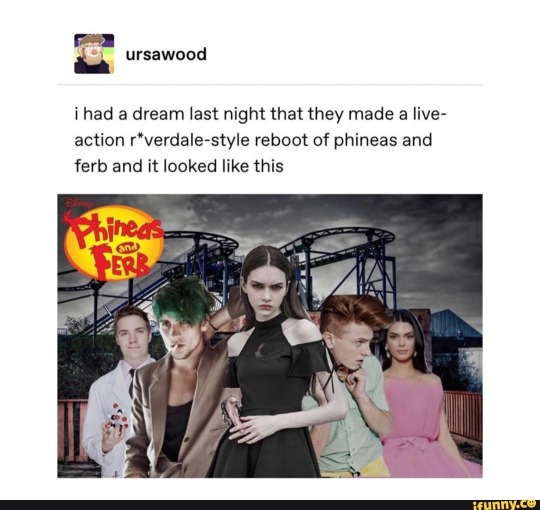
#I have said my peace and now I’m logging off for the day#anyways lets pray MGA never gives over their rights to the CW haha!#long post
29 notes
·
View notes
Photo

Drawtober2021 Send In The Clowns 10.3.21 “Post-Parade”
Have you seen the fatigue beneath
The whitewashed beaming red smile
Of a Carnegie Hall clown
At the end of the night
When the lights and frights
And the damsels and knights
Take refuge behind big-top towers
Light switches powered down
And the bright toothed grin
Slumps, like shoulders down
Unmoving at their side: resting?
Have you ever seen the face of glee
Peeled back, like exfoliation
The act of being reborn,
Of identity changing
Like the week between summer and autumn
Changing, remaining unchanged
Exaggerated in their features
Just like all the creatures
Of the dark
Have you ever seen the end of the night
When the districts red lights
Turn to floodlight phosphorescent whites
And the illusion fades like a Las Vegas mirage
Where the smiles and the heaps of garbage
Peanuts and popcorn
Swept, shoveled, and blown away
Like rodeo clown tumbleweeds
Rolling away
With a dust devil trail in its wake
Where last night there was festivity
The morning shows only imprints in the ground
Have you ever seen the shadow of smile?
@env0writes C.Buck
Ko-Fi & Venmo: @Zenv0
Support Your Local Artist!
#env0 writes#twcpoetry#inkstay#writeblr#poetryportal#themonkeyreview#writerscreed#heartsacrossthestreet#abstractcommunity#savage words#smittenbypoetry#poeticstories#poetscreed#poetryriot#poets and writers#poets community#poets on tumblr#drawtober#drawtober2021#send in the clowns#circus#writing challenge#lgbtq writer#kofi#clowns#carnival#closing time#creative writing#poem#poetry
7 notes
·
View notes
Note
thanks for being against this and being mad at Jensen. the delusion at the idea that it's not going to romanticize and whitewash his abusive parents and their terrible actions is enraging. dean girls - DEAN GIRLS - are really okay with this when it stomps even more on his life and will force him to be an apologist and will give dean cr/tical fandom even more reason to hate him? absolutely not. who the hell CARES when we know how this story ends and it's with their sons dead/suffering for NOTHING
Know what, Nonny, I drafted this response before going to be at 7am as not to post something I’d regret, woke up quickly with a thought, why be mad at a real person for a fictional story. And then it hit me again that jensen will make dean whitewash his abuser and tell his love story. And I’m fucking mad again, so here we go, under the cut because it got long:
Let me preface this by saying that this isn't meant as hate on jensen. I'm angry at him for this specific thing, I'm disappinted that he's doing dean this fucking dirty and i'm fucking tired.
I also don't want this to be an attack on dean girls, we've all been through too much and we're all trying to deal with the crap we've been handed, in our own ways
But if any dean girls want to explain to me how exactly is this supposed to be good or at least not insulting, I'd love to discuss
Frankly, it feels like, at least among the dean/jensen girls, jp*d accidentaly did jensen a favor, because when you're protective of him there's just this snap in your head and you're all ready to defend him against jp*d fans lmao. Trust me, I felt it too
For real though, the things moved pretty quickly from the anger to lolz at the twitter drama and now that that's over we're gonna be left to stew in it so we'll see how that's gonna go. (actually I really hate that the drama derailed the anger)
But yeah, agreed, I don't see how there's anything to defend here. firstly J*hn and M*ry simply shouldn't get to have their story told especially since we already know the story! what the fuck is there left to say that isn't seven retcons wrapped in a burrito or whatever else crap that'll be showing how awesome they were? Some new freaking mythology shoehorned just for the sake of keeping milking it, that doesn't make any sense in the universe? Oh well, guess that's spn's middle name.
But no matter what they do, here's the thing:
Abusers don't fucking deserve to have their story told, I don't give a flying fuck how fucking wonderful he used to be. Oh yeah he was nice and lovely and believed in good even after war, and he loved mary and was so cute, basically a puppy yadda yadda. I don't care. He lost that fucking right when he started turning his sons into soldiers, leaving them alone in crappy motel rooms, using them as fucking bait for monsters (just to mention a few)
And they especially don’t deserve to have it told by the child they abused when said child can’t even fucking say a bad word about them because this isn’t about him.
And there’s a big difference between the complicated emotions Dean might have for Dean, both hating him and loving him because he’s his dad, and the entire freaking show about the good guy young j*hn winchester.
And as amazing as Dean is, he’s not gonna be the narrator this story would deserve bc he’s not gonna serve us takes like “aw how cute my dad is making PB&J. when I was 14 16 he said I can rot in jail for stealing peanut butter to feed sammy.”
We ALREADY fucking saw Dean forgiving john without john doing anything to deserve it because he's d*bbs fave or some shit. was saw dean drink his fucking crappy beer and smiling and we narrowly missed dean and j*hn hugging it out at the roadhouse. i don't fucking wanna hear dean say it was a tragedy that changed him and its not j*hns fault :(((((( or whatever else fucking apologia we're gonna hear from him like none of this fucking mattered. dean's already been tossed to trash by the finale, what's the difference i guess, might as well move the whole bin into the trash compactor
(actually now that I think about it john ended up having a redemption arc that was entirely dean’s emotional labor over 15 years, while john was dead lmao. just because dean made peace with his life doesn’t excuse john one fucking bit)
or well, since it's a spin off about j&m is there even gonna be so much as a mention of how fucking awful they will be in the future? will the people who tune in just for TW (oh lmao nice acronym. TW on the CW, cool) without watching spn even realize they're watching a show about a future child abuser or are they just gonna fall in love with a cute matt c*hen look-alike, this sweet guy who loves mary so much OTP OTP OTP #relationshipgoals???
And as for Mary, what she used to be like before dean was born doesn't change anything of what she did to dean, the way she never tried to get to know him and took every possible chance to put as many miles between her and her sons as possible. Thanks to amara's little test, that ship has sailed
Like I'm really trying to look at this having put away the hurt and disappointment I feel now that the hope of jensen giving Dean his life back is gone. Because sure I'd feel it whatever other story jensen would decide to tell. But any other story wouldn't be a deadseaful of salt on that wound.
Or hey maybe it is some sort of a cruel twisted chance at closure if in the last 2 days I went from "let him live again one day" to "please, just let him rest in peace. Leave him out of this if you have to do this crap, please." This is so fucking insulting to dean and it just makes his death so much worse. I don't fucking want a constant reminder that he's eating lasagna with that fucker like it's a picture perfect family in a tv commercial. While still being dead. I don't want him to be telling a love story if he never got to and never will live through one*
*I'm not counting cassie bc it was so short it was barely a story and according to jensen lisa doesn't count either
But to the point. I think there is a solid line between not shitting on jensen and being able to criticize this project. You don't have to praise it just because jensen is making it. dean and jensen girls would not be trying to excuse it if it was jp*ds or d*bbs or whoever the fuck else's. why should it get a pass just because it's jensen's?
I for one am so fucking disappointed that jensen would throw Dean under the bus like this, and for what? Because I'm really not seeing any love here. I don't know, maybe he's lived with dean's death for so much longer that he's desensitized. he's moved on to better things, dean's not that important, he's just a tool to tell this story that will allow jensen to be in it
Funny, I always thought jensen was one of those who recognized j*hn was awful and that he fucked dean up. for fuck's sake he was the one who headcanoned that dean turned tricks in his youth because j*hn left them without money for food. But what do I know, I never really kept track of what the cast said except for these last year and a half, maybe he’s always thought the guy was awesome and misunderstood.
but hey, he's a rich guy with the rights to the universe and the means to do whatever he likes with them and this is what he chose to do with them, which makes things very clear. From his perspective things are mighty different than from where we're standing.
By the way I really hope they actually expected the backlash. Otherwise, if jensen and danneel thought the show's fans were gonna be happy about it meant they had to be living under some fucking rock at the bottom of the marianas trench or never cared about how the fandom feels. I don't see any other option here. well besides the obvious one.
Or maybe they're just really filled with so much hubris they think they can actually make a show about two most hated characters from the og show a hit. or that a slapped on voiceover by a beloved and still grieved character will be enough for that the way jp*d is enough to have his fans keep w*lker afloat. Or hey maybe they'll just gonna market it to the riverdale and legacies audience who won't even fucking know this shouldn't be a cutesy teenage love affair with some monsters
I know it was so, so easy to fall for “my first love”, “my best imaginary friend” and “he’s not going anywhere, I got him”. I mean, how could we not? We love Dean so much we wanted to believe jensen feels the same way. But in the end, for jensen, dean is a character he played on tv, and that’s all, he couldn’t possibly feel about him the same way we do. And we gotta remind ourselves that he loved the finale, said that it was an awesome way to end the show and that snuffing dean was the right thing to do. He and j*red practically rewrote that entire deathbed dialogue and added the ak/f crap. He said Dean’s ending was satisfying. Why would he ever try to destroy an ending that great?
I just wish he never teased us with the possibility of dean getting his life back on that panel
However we thought jensen feels about dean or his parents or any of it is just our projecting, so i guess the fault is just mine that I'm disappointed. damn I really screwed up that no parasocializing part didn't I?
Sorry this got so off-topic. I’m furious and no amount of rambling about it will help.
Fuck, I still can’t believe he and danneel are fucking doing this
“who the hell CARES when we know how this story ends and it's with their sons dead/suffering for NOTHING”
amen
#remember when we thought he was so good at stories that he knew the finale was wrong#and then he said no actually it was awesome#yeah#anonymous#ask#like for fuck's sake jensen was chewing gum while playing dean lmao i feel like that speaks volumes to the amount of care and respect there#there's probably more that I wanted to say but don't remember#also kripke what the fuck thought at least you would remember what a bastard you wrote how can you support that#oh wait right it was 10+ years ago and he also moved on#idk I'm a creator too#I like to think that if I end up writing original fiction I will CARE about my characters and stories#when does that change? with the first paycheck? or with the first high enough paycheck? is there a threshold?#or is that a healthy adult person thing to do and i'm too unwell to see things this way?
13 notes
·
View notes